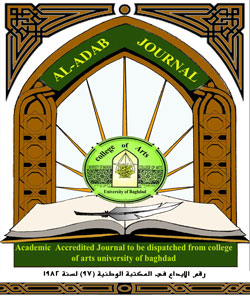Anti-Militarism in Joseph Heller's Catch-22
DOI:
https://doi.org/10.31973/aj.v0i114.1368Keywords:
/Abstract
The paper attempts to address Joseph Heller in his novel, Catch-22 (1961). An examination of the content of the novel in relation to antimilitaristic concepts is a major focus of the paper. The paper depicts various characters in the novel and tries to show how they reflect antimilitarism. The effects of particular behaviors and the major events that take place in the Air Force are discussed in the paper. The story mainly revolves around some airmen who were combatants in World War II. The events discussed in the paper clearly highlight the sentiments held by antimilitarists on war issues. The plot of the novel is sequential and the description of events is comic. The characters represent various characteristics that can be used to develop a plot on antimilitarism.
The paper bases its literature of the aspects of the military that necessitate and justify the rise and development of antimilitarism. Socialism is a notable aspect of antimilitarism while militarism seems to conform to capitalism. From an antimilitaristic perspective, capitalism is characterized by a type of bureaucracy that demoralizes soldiers and promotes individuality within the military. Catch-22 deals with all the militaristic and antimilitaristic factors and events that lead to the same aspects.
Downloads
References
Bloom, Harold. Joseph Heller's Catch-22. New York: Bloom's Literary Criticism, 2009.
Cockburn, Cynthia, and Cynthia Enloe. "Militarism, Patriarchy and Peace Movements." International Feminist Journal of Politics 14, no. 4 (December 2012): 550-557.
Cockburn, Cynthia. Anti-Militarism: Political and Gender Dynamics of Peace Movements. Basingstoke: Palgrave Macmillan, 2012.
Daugherty, Tracy. Just One Catch: A Biography of Joseph Heller. New York: St. Martin's Press, 2011.
Doloff, Steven J. 2007. "Heller's Catch-22." Explicator 65, no. 3: 180-182.
Dziennik, Matthew P. 2012. "Hierarchy, Authority and Jurisdiction in the Mid Eighteenth-century Recruitment of the Highland Regiments." Historical Research 85, no. 227: 89-104.
Heller, Joseph. Catch-22. New York: Dell Publishing, 1990.
Koepfler, James, JoAnne Brewster, and David Englert. "Characteristics of Decredentialed Agents in a Military Law Enforcement Agency." Military Psychology (Taylor & Francis Ltd) 24, no. 4 (July 2012): 347-362.
McDonald, Paul. Reading Catch-22. Penrith: Humanities-Ebooks, 2012.
Morkevičius, Valerie. "Power and Order: The Shared Logics of Realism and Just War Theory." International Studies Quarterly 59, no. 1 (March 2015): 11-22.
Mundey, Lisa M. American Militarism and Anti-Militarism in Popular Media, 1945-1970. Jefferson, N.C.: McFarland & Company, Inc., Publishers, 2012.
N. N. , Book Caps. Catch-22 (Study Guide): New York: Book Caps Study Guides, 2012.
Rottman, Gordon L., Peter Dennis, and Martin Windrow. World War II Battlefield Communications. Oxford: Osprey, 2010.
Scheckner, Peter. "Renegades in the Literature of War: From Homer to Heller." War, Literature & the Arts: An International Journal Of The Humanities 21, no. 1/2 (November 2009): 197-206.
Downloads
Published
Issue
Section
License
Copyright and Licensing:
For all articles published in Al-Adab journal, copyright is retained by the authors. Articles are licensed under an open access Creative Commons CC BY 4.0 license, meaning that anyone may download and read the paper for free. In addition, the article may be reused and quoted provided that the original published version is cited. These conditions allow for maximum use and exposure of the work.
Reproducing Published Material from other Publishers: It is absolutely essential that authors obtain permission to reproduce any published material (figures, schemes, tables or any extract of a text) which does not fall into the public domain, or for which they do not hold the copyright. Permission should be requested by the authors from the copyrightholder (usually the Publisher, please refer to the imprint of the individual publications to identify the copyrightholder).
Permission is required for: Your own works published by other Publishers and for which you did not retain copyright.
Substantial extracts from anyones' works or a series of works.
Use of Tables, Graphs, Charts, Schemes and Artworks if they are unaltered or slightly modified.
Photographs for which you do not hold copyright.
Permission is not required for: Reconstruction of your own table with data already published elsewhere. Please notice that in this case you must cite the source of the data in the form of either "Data from..." or "Adapted from...".
Reasonably short quotes are considered fair use and therefore do not require permission.
Graphs, Charts, Schemes and Artworks that are completely redrawn by the authors and significantly changed beyond recognition do not require permission.
Obtaining Permission
In order to avoid unnecessary delays in the publication process, you should start obtaining permissions as early as possible. If in any doubt about the copyright, apply for permission. Al-Adab Journal cannot publish material from other publications without permission.
The copyright holder may give you instructions on the form of acknowledgement to be followed; otherwise follow the style: "Reproduced with permission from [author], [book/journal title]; published by [publisher], [year].' at the end of the caption of the Table, Figure or Scheme.












